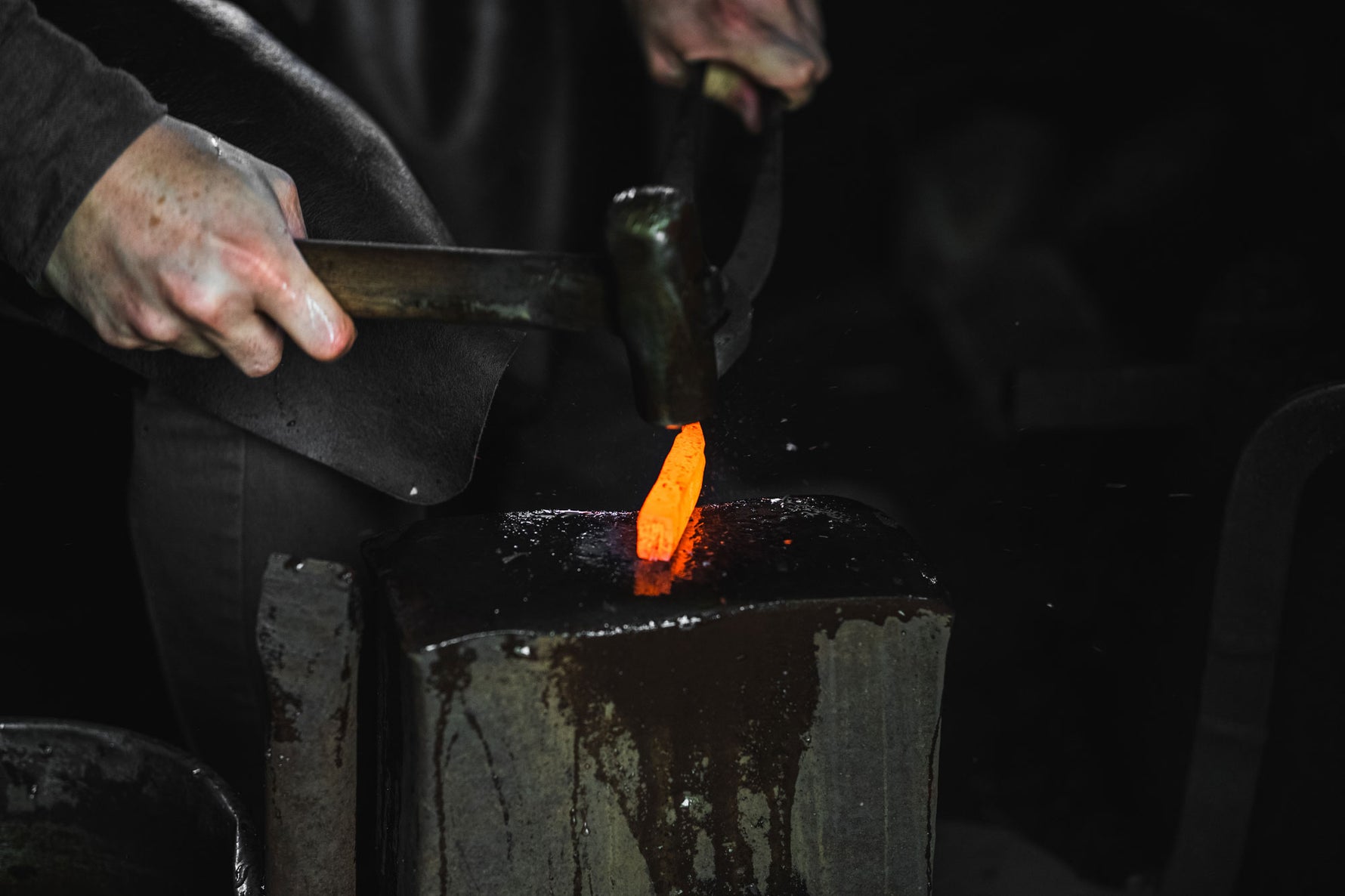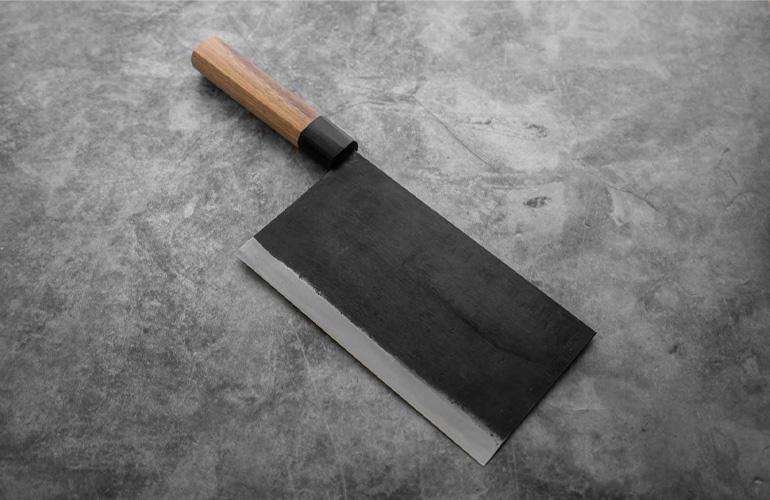Knife Information

How to Make a Japanese Knife
Many people have a deep and entirely justifiable fascination with Japanese knives. Sharpness is part of the intrigue: learn more about the history of tameshigiri, if you want proof of the power of these blades.
There's also a fascinating background of how Japanese knives are made. A certain part of the forging process can only be performed after dark so that the blacksmith can better judge what color the metal is glowing — you've got to admit that's unique.
But aside from intrigue, people love the quality of these knives, thanks to how they're made. Here, we look at the process that Japanese knives are put through to obtain that incredible quality. Let's start with a breakdown of how they differ from Western knives.
What's the Difference Between Japanese Knives and Western Knives?
There are a few major differences between many Japanese knives and Western knives:
Single bevel (Japanese) vs. double bevel (Western): the single bevel means that a blade is better suited to one hand than the other and can hold a sharper edge for more delicate cuts
Harder, more brittle steel: Japanese knives tend to be made of harder steel. This is more brittle but holds an edge for longer if treated with respect.
Single-piece vs. composite handle: Western knives tend to have a handle made of two pieces of wood riveted together around the tang. In Japan, the tang is traditionally knocked into a single block of wood.
So, it's clear Western and Japanese knives are very different, but how are these blades made? There are numerous production modes, but we'll just look at two: the high-quality factory method and the mysterious, romantic hand-forged method.
How to Make a Japanese Knife in the Factory
Rest assured that this isn't your typical ‘factory-made’ knife. There may be a team of workers and machinery, but the care that goes into forging these knives is still exquisite. It starts, of course, with the metal.
Step 1: Initial Shaping
Blanks of metal are heated in a forge and then pounded out with a power hammer. The metal is then periodically quenched to give it strength. This process leads to the blades taking on their basic form and achieve uniform strength in all parts.
At the end of the shaping, the blades are treated on a sanding belt. The shape of the blades is controlled and carefully monitored by expert craftspeople. As mentioned, this isn't your typical factory.
Step 2: The Kiln
The knives are put into a kiln and then cooled at a controlled pace a day after the initial shaping. The heating and cooling changes the metal's molecular structure to something approaching the desired result — but not quite. There's more work to be done on day 3.
Step 3: The Finished Shape
As the knives aren't yet at the final hardness, the final stage is to make some cold adjustments. This is an intensive, meticulous process done by hand. The knives are given their desired shape and then put through the kiln one more time, which gives them the perfect hardness.
Step 4: Sharpening
Sharpening a knife is a specialized job. The blades are sent to experts who sharpen the blades to an unbelievably fine grade. Even here, the temperature is key: the wheels that sharpen the blades are kept cool with water, as raising the metal to high temperatures would compromise its quality.
The knives produced using this method are sharper and of better quality than what you'll find in many restaurants. Here's what you wanted, though: the handmade method.
How to Make a Japanese Knife by Hand
Step 1: The Furnace
Masters in forging Japanese knives also start by heating metal in a furnace. So far, so familiar. Just like a great chef knows when a steak is perfectly medium-rare by touch, a master blacksmith knows when the metal is hot enough by its color, as well as other signals that the untrained eye just won't notice.
The metal is shaped with an air hammer and the watchful eye of the blacksmith. Precision is the key to perfection here, and not a single blow is wasted.
Step 2: Cold Forging
‘Cold forging’ means that the metal is, well, almost cold. This makes it far harder to work with than hot metal but yields far superior results. If you don't know what you're doing, it's easy to damage the metal by cold forging.
The blacksmith cold forges the knife to make the metal stronger on a molecular level than if it was hot forged. This job is sometimes given to a master craftsman's apprentice, which can seem an odd term for someone who already understands metalworking better than most mortals.
Step 3: Quenching
The blade is heated and then quenched to bring it to a desired level of hardness. Such is the need for perfection that it's important to use the right fuel for the furnace.
Coal, for example, contains a lot of impurities that make it unsuitable for this refined process. Think of your dad's bourbon-soaked hickory wood chips for his beloved barbecue, but on a whole different level.
The blacksmith knows instinctively what color the metal's glow has to be. This is why quenching only takes place after dark.
Step 4: Tempering
The blade must then be tempered to achieve the final, desired hardness. This takes place in carefully controlled temperature conditions and is essential before the blade can be sent off for sharpening.
Step 5: Creating a Legendary Edge
A top-quality, hand-forged knife deserves no less than the best to put an edge on it. A master knife sharpener is known as a togishi. This person's job is to put an edge on the blade that matches the quality of its construction.
A Labor of Love
Japanese knives are works of art in their own right. The care and years of training that go into producing a quality knife are formidable, and this is true of specialized factories and hand-crafted knives.
If you're interested in Japanese knives, something you might want to put on your bucket list is taking a tour of a workshop. Japanese knives also make wonderful gifts, as each one has a story behind it. Let your fascination take you further into this amazing world: ask any ‘apprentice.’ There's always more to learn!

Choosing The Right Chef Knife For You
Never heard of a Gyuto? No idea what SG2/R2 is? Double or Single Bevel? Don’t panic, we’ll explain what you need to know when picking out a Japanese Chef knife.
If you’re in the market to purchase a Japanese kitchen knife, you might be looking for a timeless, meaningful gift, interested in the culinary arts, a chef, or simply wanting to cook a delicious meal for your loved ones.
There are many different Japanese knives, so much so it can be a little overwhelming to make a choice. Here, we cover a few main points to consider when choosing the right Japanese chef knife for you.
Blacksmith
Taking the maker of your knife into account can give you an idea of the overall quality you will be receiving. The manufacturer will influence the design, balance, performance, and price of the knife.
Different blacksmiths will also prefer to use particular steel, which may have some benefits over other knife steels available. As the craft of knifemaking is a traditional art form passed down through generations, it is something Japanese blacksmiths hold very dear.
Through the application of these varying techniques, each blacksmith continues the traditions of their forefathers, producing a knife that is unique to that families history, a culmination of (sometimes) hundreds of years of tradition. Some people prefer to have matching sets from one blacksmith, while others do not mind mixing and matching different blacksmiths to create a set that they are happy with. This is personal preference.
Style
The style of knife you buy depends largely on what you’re looking to do with it and what you are preparing. Whether you’re preparing sushi or peeling vegetables, the process of chopping and slicing is very different and a different knife will be required.
Make sure you know how you are primarily looking to use the knife so you can select the correct style. A home cook that would just like to own a high-performance knife might lean towards a Santoku between 160-180mm, whereas a professional chef with a wide variety of tasks to complete may opt for a Gyuto of 210mm length or more, and a petty or small utility knife to cover the smaller tasks at hand.
Blade Material/Steel Combinations
We could write an entire article just about this! (In fact, we might just do that!) The type of steel used in a Japanese chef knife may not seem overly important, (as long as it’s sharp, right?)
Not quite!
The blade material will impact many things; how long your knife lasts, how easy it is to sharpen, the overall look, and more. You may consider getting a knife made of the simpler AUS8, Molybdenum Vanadium, or VG1 steels if you are just entering into this market and feel overwhelmed by the choice. This type of knife is more chip resistant and a little tougher than other options.
If you’re a more advanced user of knives and you’re comfortable putting more care and effort into them, consider using some of the higher hardness, more complex stainless steels like VG10, R2/SG2, SRS-15, AEB-L, HAP40 or ZDP-189.
Then you must consider the carbon steels. They have a higher maintenance requirement, but they can be used by all skillsets. Most Japanese blacksmiths will prefer to use the traditional Japanese chef knife steels, made by Hitachi Metals. These are the White Paper Steels (Shirogami), Blue Paper Steels (Aogami). There are some slight variations of Blue and White paper steels, but they are essentially about as close to the samurai sword steels of hundreds of years ago we have today.
They are high in carbon content, resulting in the steel being harder than almost all other knife making steels, ensuring they will stay sharper for longer.
They are, however, what is called ‘reactive steel’. This means they will oxidize (rust) and form a ‘patina’ (a discolouration of the steel) and also develop rust spots if they are not kept dry between uses.
In some cases, 15 minutes left wet will be all it takes to form early rust spots. This is avoided by proper care and maintenance, but also by a blade construction technique called ‘san-mai’, which uses a core or cutting edge of high carbon steel, with a softer stainless steel clad on either side. This results in exceptional performance with minimal maintenance.
Size
A larger knife generally means you can perform more work with it, however, your workspace should also then need to accommodate a larger knife. The knife you purchase should not be longer than your cutting board is wide.
That being said, you don’t want your knife to be too small, or too large to perform everyday tasks. A general purpose knife for most like a Santoku of 160-180mm is, therefore, a great place to start. Once your Santoku becomes either too large or too small, it’s time to expand! Look for petty knives around 100mm for smaller delicate tasks, and Gyuto’s up to 240-300mm for larger tasks like carving meats, but beware of bones!
Handle Material/Shape
The handle material may impact how you grip the knife, how sturdy the knife feels as you use it, as well as the appearance of the knife.
A steel handle, a feature of many western knives may slip or not feel as comfortable in the hand and a timber handle crafted into the shape of an octagon. The octagon handle shape is one of the marks of a traditional japanese chef knife, as it allows the edges of the octagon to fit into the grooves of the fingers once the handle is grasped in the hand.
Chefs Edge has a preference towards the octagon handle, and as such we partner with craftsman worldwide to create stunning unique handles made from exotic timbers.
Bevel Angle Ratio
The traditional Japanese chef knives (Yanagiba, Sujihiki, Deba etc) are designed to have a single bevel. This one-sided bevel angle is perfect for sashimi slicing, but is not well suited to everyday cooking at home or in a professional kitchen for general use.
The Japanese blacksmiths have realized this, and almost always craft the Gyuto/Santoku/Nakiri/Bunka with an even 50:50 bevel to accommodate the western chef with a varied set of kitchen tasks.
HRC
The HRC of a knife refers Rockwell Hardness Scale. A knife with a higher HRC, in general, will retain its edge for longer, but can be more brittle.
This is why a Japanese chef knife should never be used to chop bones, frozen objects, or hard foods (sometimes a big sweet potato is a no no!) It’s also important to remember that not all steels behave the same at higher hardness, and higher hardness is not the sole determining factor of knife performance.
Just because something has a high HRC rating doesn’t make it a better knife. A regular European chef knife made from a softer steel may be hardened to 55-56 HRC, but a Japanese knife made from Aogami Super or ZDP-189 may be hardened anywhere up to 67-68 HRC.
At the end of the day, there are a wide number of factors to take into account when choosing the right knife for you. If you get stuck, please don’t hesitate to get in touch by any of the channels on our website, or send us an email to info@chefs-edge.com.au!
